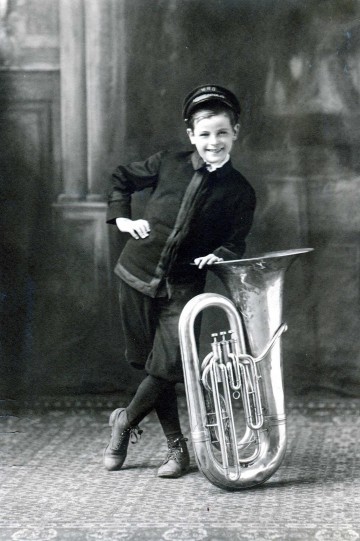


Park Square and History Theatre open shows this week not seen before in the Twin Cities.
Two premieres — one world and one regional — make St. Paul a theater destination this weekend. They will be cutting the ribbon on “Working Boys Band” at History Theatre on Saturday. Just down the street at Park Square Theatre, “Behind the Eye” gives Minnesotans a first look at a play that’s been around a few years.
‘The Working Boys Band’
Prof. Harold Hill had it right all along. Remember? The slick-talking huckster said music was the cure for the wayward youth of River City. Put an instrument in a boy’s hands and he can’t hold a pool cue, can’t get into mischief — can’t turn into a juvenile delinquent.
“The Working Boys Band,” a new musical, brings to stage the story of a real-life Music Man. About 100 years ago, Prof. C.C. Heintzeman formed the Minneapolis Working Boys Band to bring structure and discipline to lads living hardscrabble lives on the Mill City’s meager streets.
Heintzeman emigrated from Germany and moved to Minneapolis from Rhode Island in the early part of the 20th century. He taught music at Hamline University and conducted bands. In the play, written by Dominic Orlando and composer Hiram Titus, Heintzeman persuades authorities to let him start a group with kids who worked in factories. There’s nothing like a uniform and a musical instrument to raise self-esteem and purpose, Heintzeman maintained.
Martin Segal, a retired doctor who lives in Edina, played in a Depression-era iteration of the Working Boys Band.
“If you heard Sousa’s ‘Semper Fidelis’ coming down the street, that was the Working Boys Band,” said Segal, who at 93 still plays clarinet in the Richfield Symphonic Band.
The Heintzeman concept was still the same when Segal played as a teen: “In order to keep the kids from getting into trouble, they gave them instruments,” he said.
A mentorship also formed, Segal recalls. Older band members would school newcomers on reading music and proper technique.
“Our uniforms were beautiful red flannel jackets, the pants were blue with a big red strip down the side. And we added a gold braid in high school,” he said.
For Segal, the History Theatre musical has a special poignancy. He knew Titus as a child — “a child prodigy,” he called the composer. Titus died last September at age 66, shortly after finishing the finale for “The Working Boys Band.”
(8 p.m. Fri.-Sat., 2 p.m. Sun., 10 a.m. & 8 p.m. Thu. Ends June 1, History Theatre, 30 E. 10th St., St. Paul, $15-$40, 651-292-4323 or historytheatre.com)
‘Behind the Eye’
Here’s a life for you: Lee Miller was a Vogue model before she became a muse and model for Man Ray and other surrealists. That was before she went to Europe during World War II as a war photographer. And that was before she retired to the English countryside, exhausted by what she witnessed in the war. Still, in the final act of her life she became a respected gourmet cook and played host to many of the great artists who had worked with her previously.
Minneapolis-based playwright Carson Kreitzer takes on Miller’s story in “Behind the Eye,” which opens Friday at Park Square. Leah Cooper directs a cast that features Annie Enneking as Miller.
“It’s a little intimidating to look at someone’s life with such an epic scope,” Kreitzer said. “She discovered and tasted and experienced everything there was to experience.”
Kreitzer first came across Miller’s story when she read a review of a 2005 biography. Miller, who grew up in upstate New York, posed nude for her father, an amateur photographer, before she caught the attention of Condé Nast in New York. He employed her as a model at Vogue magazine before she was 20 years old and for three years she was a highly sought fashion model. She went to Paris in 1929 with a letter of introduction to surrealist Man Ray. She became his muse, collaborator, lover and model.
Eventually, Miller got out from in front of the camera and started to exercise her own eye for photography. She returned to New York, opened her own studio, ran off with an Egyptian businessman, got bored, returned to Paris and met Roland Penrose, a British artist.
They were living together in England when World War II broke out. Miller became a news photographer for Vogue and documented the London Blitz, the liberation of Paris and, most famously, the liberation of the Nazi concentration camps. Her colleague David Scherman, a Life magazine correspondent, photographed her in Hitler’s bathtub in Munich.
She covered fashion and celebrities for Vogue after the war but retreated to the English countryside with Penrose. She slipped into depression and alcoholism even as she continued to host artistic royalty at her country home.
Kreitzer developed her script at the Playwrights’ Center in Minneapolis before the play had its premiere at Cincinnati’s Playhouse in the Park. Interestingly, that production starred Minneapolis actor Sarah Agnew as Miller.
“There’s a lot to weigh in [Miller’s] life, and it’s a question she asks, ‘What did it all add up to?’ ” Kreitzer said. “That’s a question any of us will have to deal with. Her struggle in reconciling the facets of herself is a struggle we all can appreciate.”
(7:30 p.m. Fri.-Sat., 2 p.m. Sun. Ends May 18, Park Square Theatre, 20 W. 7th Pl., St. Paul, $38-$58, 651-291-7005 or parksquaretheatre.org.)
Graydon Royce • 612-673-7299
Go to StarTribune.com